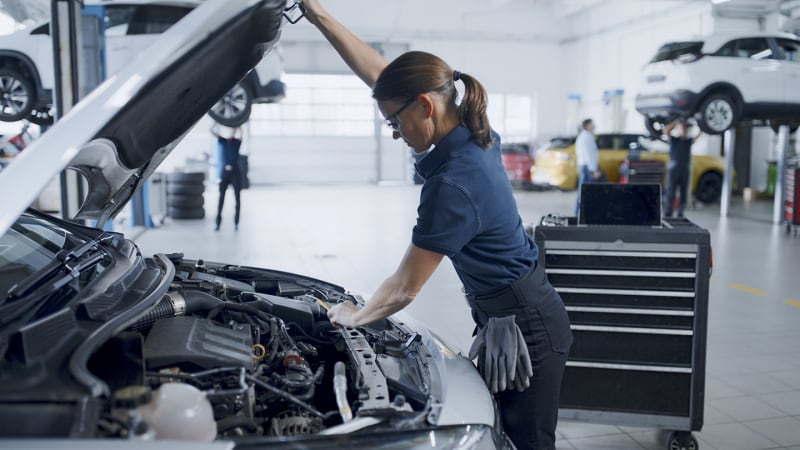How car engines work

Quick insights
- Gas-powered cars contain combustion engines which get their torque from a series of continuous explosions happening under the hood.
- There are several common car engine layouts that provide different performance benefits, identifiable by how the cylinders are arranged.
- Maintaining your engine can lead to better automotive performance and longevity.
If you've ever gotten behind the wheel of a car to drive, you know that pressing down on the right pedal makes the car go. For many people, this basic information about how a car works is sufficient to satisfy their curiosity. But if you want to know more about what happens under the hood, stick around: In this article, we'll identify the key components of gas-powered engines, explain how they work and describe common car engine layouts. We'll also discuss how to maintain a combustion engine for both performance and longevity.
Car engine basics: What are they and how do they work?
A car's engine is its heart: It generates the power needed to move the vehicle forward. The power from an internal combustion engine (ICE) is created through a series of tiny explosions, each fueled by a mixture of gasoline and oxygen ignited within a stable chamber. It may be alarming to imagine explosions happening within your car's engine, but rest assured, they are well-contained and happening constantly without you even knowing it.
Most vehicles on the road are built with what's called a "four-stroke engine," which is driven by the movement of pistons firing constantly to turn the crankshaft. This activity happens within the cylinders of a car. Most gas-powered cars on the road contain an arrangement of four, six or eight cylinders. The higher the number of cylinders, the more combustion reactions happening at once and the greater the power of the engine.
Parts of a four-stroke engine
Four-stroke engines may seem complex at first glance, but there are a limited number of important parts driving the engine's combustion within each cylinder.
- Engine intake and exhaust valves: These are the stopping points that limit and allow for the influx of fuel and the expulsion of exhaust.
- Combustion chamber: This part of the engine contains the tiny explosions that create the power needed to propel a vehicle forward.
- Piston: This mechanical component moves up and down to create a vacuuming and compressing effect on the air and fuel mixture, essential to the combustion reaction.
- Crankshaft: This engine part rotates around a set point below the combustion chamber, mechanically driving the piston up and down by way of a connecting rod.
- Spark plug: This electrical component ignites the fuel and air mixture in the combustion chamber, creating a small explosion.
How four-stroke engines work
Most modern vehicles have a four-stroke (or "four-stage") engine. These engines have four stages of movement which rule the process of combustion.
- Stage one, intake: The piston is pulled down by the crankshaft, drawing a mixture of air and fuel into the engine's combustion chamber.
- Stage two, compression: The crankshaft rotates and pushes the piston upward within the engine, compressing the mixture of air and fuel.
- Stage three, combustion: At the "dead center" (or the top position of the piston's travel), a spark plug ignites the fuel and air, causing a combustion reaction.
- Stage four, exhaust: The power of the combustion pushes the piston back downwards, turning the piston back to the first position, and engine exhaust is released through a valve.
Common car engine layouts
There are three main layouts for gas-powered engines: inline engines, v-type engines and flat engines. The differences between these ultimately come down to the position of cylinders and how they exert force on the crankshaft.
Inline engines
As the name suggests, inline engines (also referred to as "straight" engines) have all their cylinders lined up in a row. This results in a longer overall shape, so you're less likely to see a high number of cylinders in this configuration due to vehicle size restrictions. Inline engine designs have become increasingly popular in recent years due to their efficiency and low emissions.
V-type engines
V-type engines have their cylinders assembled in a V shape, typically at a 90-degree angle. You'll always find an even number of cylinders in this type of engine. This car engine layout features a shorter crankshaft, which helps cut down on the space the engine takes up. V-type engines are often preferred for vehicles that have a low hood. This type of engine is also known for producing more torque at a lower RPM.
You may be familiar with V6 or V8 engines, which are both typical configurations for modern vehicles. While both are popular configurations, V6 engines (with six cylinders) are considered to be more stable and provide better handling than a V8 engine due to their lighter weight. What V8s lack in handling they make up for in power and acceleration. When it comes to fuel efficiency, V-type engines with fewer cylinders tend to consume less gas than those with more cylinders.
Flat engines
Flat engines have the lowest height of all gas-powered engine layouts due to their level arrangement. The cylinders in a flat engine are laid horizontally and appear to punch toward each other. This orientation has led to flat engines being nicknamed "boxer engines." Flat engines have a reputation for being aerodynamic and extremely well-balanced due to their low center of gravity. For these reasons, they are often used in high-performing sports cars.
Maintaining your car engine
No matter the layout of your car's engine, regular maintenance is key to long-term use and performance. For most vehicles, the major points of upkeep include regular oil changes, air filter cleaning, spark plug replacements and fluid level maintenance. Embracing "gentle" driving habits (for example, accelerating gradually, braking steadily and avoiding excessive idling) can also help you keep your engine in good shape. Finally, it's important to listen to your engine for issues and take it to a reputable mechanic for repairs when needed.
Bottom line
All things considered; gas-powered vehicles are less complex than they may seem. Most combustion engines have a similar array of recognizable parts, though they can be arranged in different configurations for various performance benefits. No matter the type of car engine, regular maintenance and careful driving can help it last longer and deliver a smoother ride.



